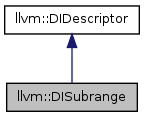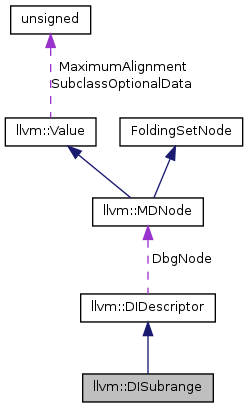DISubrange - This is used to represent ranges, for array bounds. More...
#include <DebugInfo.h>


Public Member Functions | |
| DISubrange (const MDNode *N=nullptr) | |
| int64_t | getLo () const |
| int64_t | getCount () const |
| bool | Verify () const |
| Verify that the subrange descriptor is well formed. | |
Friends | |
| class | DIDescriptor |
Detailed Description
DISubrange - This is used to represent ranges, for array bounds.
Definition at line 167 of file DebugInfo.h.
Constructor & Destructor Documentation
| llvm::DISubrange::DISubrange | ( | const MDNode * | N = nullptr | ) | [inline, explicit] |
Definition at line 172 of file DebugInfo.h.
References N.
Member Function Documentation
| int64_t llvm::DISubrange::getCount | ( | ) | const [inline] |
Definition at line 175 of file DebugInfo.h.
References llvm::DIDescriptor::getInt64Field().
| int64_t llvm::DISubrange::getLo | ( | ) | const [inline] |
Definition at line 174 of file DebugInfo.h.
References llvm::DIDescriptor::getInt64Field().
| bool DISubrange::Verify | ( | ) | const |
Verify that the subrange descriptor is well formed.
Reimplemented from llvm::DIDescriptor.
Definition at line 636 of file DebugInfo.cpp.
Referenced by llvm::DIDescriptor::Verify().
Friends And Related Function Documentation
friend class DIDescriptor [friend] |
Definition at line 168 of file DebugInfo.h.
The documentation for this class was generated from the following files:
 1.7.6.1
1.7.6.1